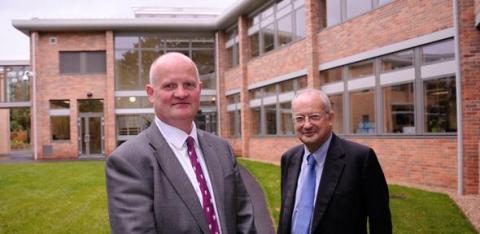A new building on the Institute of Astronomy site off Madingley Road will complete the consolidation of astronomy, astrophysics and cosmology on a single site in Cambridge.

Astronomy, Astrophysics and Cosmology have historically been among the very strongest scientific disciplines in Cambridge.
The opening of the new Battcock Centre for Experimental Astrophysics represents a major consolidation of these disciplines. Until five years ago, astronomers, astrophysicists and cosmologists at the Institute of Astronomy, the Cavendish Laboratory and the Department of Applied Mathematics and Theoretical Physics (DAMTP) were significantly geographically separated.
The Chancellor of the University, Lord Sainsbury of Turville (pictured right), was joined at the opening by the Vice-Chancellor, Professor Sir Leszek Borysiewicz and the chief benefactor who made the building possible, Mr Humphrey Battcock (pictured left).
Humphrey Battcock is a Cavendish Laboratory and Downing College alumnus who has been an enthusiastic supporter of the University’s initiatives since the beginning of the present Cavendish redevelopment programme. His gift, together with funding from the Wolfson Foundation, has been matched by the University to enable the centre to become a reality.
The construction of the Battcock Centre for Experimental Astrophysics brings together on the same site the experimental astrophysicists from the Cavendish Laboratory with astronomers from the IoA and Kavli Institute, completing the consolidation of the research efforts of the Institute of Astronomy and the Cavendish Laboratory. The consolidation will also promote collaboration with members of DAMTP in the areas of cosmology and exoplanets.
This is the first time that most of Cambridge astronomy has been brought together under one roof in order enhance the strength of these disciplines and put Cambridge in the best possible position for future developments in astronomy across the full span of theoretical, observational, interpretative, computational and experimental astrophysics.
The benefits are already tangible. The Cavendish has made two outstanding professorial appointments in Roberto Maiolino and Didier Queloz. They bring with them expertise in areas of experimental astrophysics which greatly enhance Cambridge’s ability to compete for the leading roles in the next generation of ground and space-based astronomy projects. These include instrumentation for the Very Large Telescope (VLT) in Chile, the next generation European Very Large Telescope (E-ELT), the James Webb Space Telescope (JWST) and numerous other space and ground-based astronomy projects.
Most recently, the Cavendish has appointed Professor Chris Carilli, the Chief Scientist at the US National Radio Astronomy Observatory, as a Director of Research. This will enhance Cambridge’s involvement in the extended VLA project and strengthen further the Cavendish’s involvement in the Square Kilometre Array (SKA) project.
Paul Alexander, Head of the Cavendish Astrophysics Group and Director of the Battcock Centre for Experimental Astrophysics, is the leader of Cambridge’s involvement in the SKA:
“The Battcock Centre will enable us to create the teams needed to take on big scientific challenges, which will lead to major advances in our knowledge and understanding of the Universe.”
Malcolm Longair, Emeritus Jacksonian Professor of Natural Philosophy and the Cavendish Laboratory’s Director of Development, stated:
“The completion of the Battcock Centre represents a major step forward in the redevelopment of the Cavendish Laboratory. It greatly expands the capability of Cambridge astronomers to participate in the next generation of major astronomical projects through the creative synergies between astronomers in the Institute of Astronomy and the Cavendish Astrophysics Group.”
The new building, designed by the same architects, Anand and Mustoe, who were behind the Kavli Institute for Cosmology, and constructed by Bedford-based regional construction company SDC, contains a dedicated suite of design spaces for instrumentation and computation and project rooms, as well as offices for the experimental, theoretical and observational astrophysicists.

